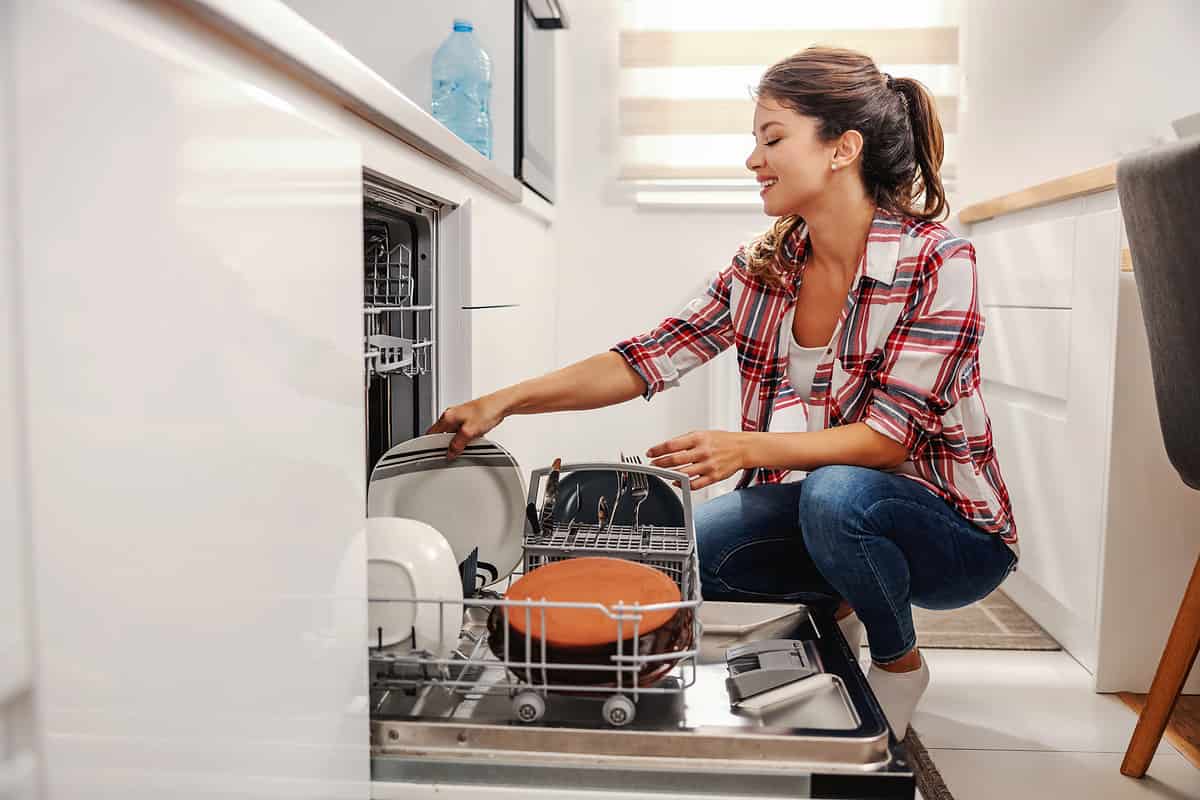

Front-Load vs. Top-Load Dishwasher: Pros & Cons for Each & Full Comparison
If you have a dishwasher in your home, you’re likely using the standard front-loading model where you pull down the door, slide out the shelves, and add your dishes. However, you may not realize that back in the day, there used to be top-load dishwashers. These were models that you pulled out like a drawer and put the dishes on top of each other. It’s hard to imagine, but they did exist. Today, we’ll tell you about the differences between front-load vs. top-load dishwasher models and explain which is best for the modern kitchen.
What is a Top-Load Dishwasher?
The story of front-load vs. top-load dishwasher models begins back in the 1850s. That’s when the first dishwasher was invented, and since there wasn’t any electricity, it was operated by turning a crank. It was made out of wood, and it worked as well as you can imagine. A few years later, socialite Josephine Cochran loved to have dinner parties, and she wanted a better dishwasher, so she made one herself. Her model was also made of wood, but it had a wheel that squirted hot and soapy water on the dishes. She received a patent for the dishwasher on December 28, 1886, and she won an award at the Chicago World’s Fair in 1893.
During the late 19th century, many restaurants and hotels started to make the dishwasher popular. These were all top-loading models. Until the 1960s, the top-load dishwasher was the primary model you’d see in kitchens across the country. They were about the size of the dishwashers we have today, except that there was a lot more machinery in the bottom. You would lift up the top door of the dishwasher like you would a modern-day top-loading laundry machine and put in the dishes. The shelf that held the dishes was pretty shallow and only allowed for one row of dishes.
Since the 1960s, front-loading dishwashers have become the norm, and finding a household with a top-loading dishwasher is incredibly rare. However, if you hunt around online, you can still find a top-loading dishwasher that you can still use today. Many of them offer quiet performance, place settings for up to 13 dishes, numerous wash cycles, and a speed-wash cycle. Many of them are cream-colored and other colors that were popular back in the early 20th century.
Cons of Top-Load Dishwashers
Back in the day, a top-load dishwasher was a standard option, and it worked well for the time. People back then generally had fewer dishes, so they did not need the larger models we have today. However, if you were to buy a top-load model in 2023, it would not be practical unless you also use the same dishes repeatedly. This model only offers a fraction of the space. Plus, when you have to wash your dishes that often, it uses a lot of water, which is bad for the environment and for your utility bills.
Dishwashers of that time were also a bit louder and not as sleek and user-friendly as the front-loading dishwashers that we use today.
Pros of Top-Load Dishwashers
In our modern age, there aren’t many pros to owning a top-loading dishwasher unless you have few dishes and you don’t wash them very often. If you did own very few dishes, you’d be better off washing them in the sink to save time and water. However, for homeowners living in the 1960s, it was an incredible invention and a status symbol.
Modern Front-Loading Dishwashers

©dusanpetkovic/ via Getty Images
In the battle of front-load vs. top-load dishwasher models, the front-load model is king, especially in our modern age. This is likely the model you have in your kitchen. It opens with a door on the front. Inside, there are at least two rows where you store dishes, cups, and silverware.
A front-loading dishwasher has numerous moving parts that clean the items inside. Most models contain a control mechanism, water intake value, and circulation pump. The dishwasher adds the water and then heats it to the appropriate level. Then, it opens the detergent dispenser at the right time to release the soap. That soap is combined with the spray arms that shoot water on the dishes. Then, the dirty water is drained. After that, more water is sprayed to rinse the dishes. The dishwasher drains the water once more. Finally, if your dishwasher has a drying setting, as most do these days, then it heats the air to dry the dishes, and the cycle is complete.
Cons of Front-Loading Dishwashers
Although 99% of dishwashers these days are front-loading models, and they’re a helpful appliance, they’re far from perfect. If you’re not careful, then dishwashers can have their downsides, including:
- They consume a lot of energy, with one load being about equal to leaving a TV on for 20 hours.
- Dishwashers can be expensive, often costing upwards of $2,000.
- If the dishwasher is not used properly or it breaks, then it can cause water damage to your home.
- They can be hard to clean.
- They eliminate the possibility for parents to teach kids about responsibility and chores, like the need to wash dishes by hand.
- Larger models can take up a lot of space in your kitchen.
- They’re hard to fix if they break.
- Use the wrong settings or run the water too hot, and they can break dishes.
Pros of Front-Loading Dishwashers
Although there are downsides, modern dishwashers are really an incredible invention, especially if you have a large family and a lot of dishes. Pros of front-loading models include:
- They free up time. While the dishes are being washed, you can do other things.
- If you run the dishwasher only when it’s completely full, then you can save water.
- There are various models and sizes, including larger washers and slim brands, that make good use of limited space.
- The pressure created inside a dishwasher makes for cleaner dishes.
- The water in dishwashers is so hot that it can kill germs.
- It’s much easier to load a dishwasher than to clean a sink of dishes. Plus, many top models are so good that you can add dishes without rinsing them first.
- Washing dishes by hand can be hard on your hands over time.
- Dishwashers are typically safer, and you have a lesser chance of dropping or breaking dishes.
Future Evolution of Dishwashers
The other big difference between the front-load vs. top-load dishwasher models is that the front-loading model will only continue to evolve.
One way that they’re evolving is that they’re becoming more eco-friendly , and many models use less water than ever before. Dishwashers that qualify for Energy Star will use less than 3.5 gallons during a normal cycle. That’s the equivalent of flushing a toilet twice, which is incredible. Eco-friendly dishwashers also use less than 270 kilowatt hours of electricity, which makes them better for the utilities.
Many new dishwashers also have unique features that make them even more efficient. For instance, many new models come with more durable shelves, and many incorporate a third rack, which allows for more dishes, though it can be a bit cramped. Soil sensors are another new feature that detects if the dishes are still dirty, and if they are, then it extends the cycle.
As more dishwashers come out, they are featuring more special wash features, such as the ability to steam clean, scrub pots, sanitize, operate with hotter water temperatures, and more. The tubs on new models are also made of stainless steel, which makes the machine more durable. Other new features include hidden buttons, low noise levels, and heated drying options that can reach up to 150 degrees for ultra germ-killing power. Just keep in mind that the more bells and whistles you have on your dishwasher, the more expensive it will be, so shop wisely.
Conclusion
This has been your history lesson and the pros and cons in the argument of front-load vs. top-load dishwasher models. It’s safe to say that most homeowners are glad that dishwashers exist, and the future looks bright.